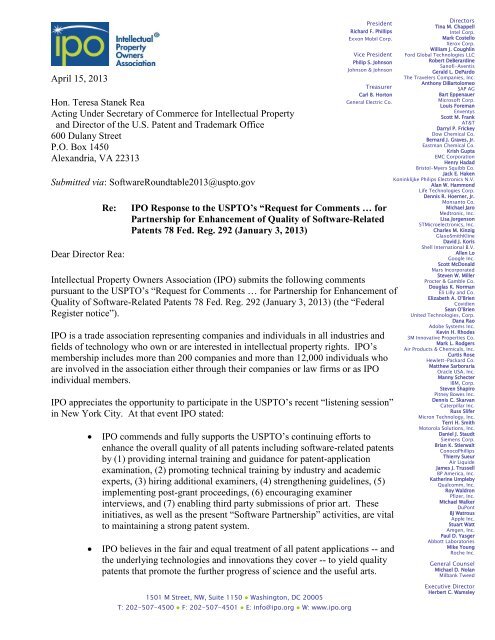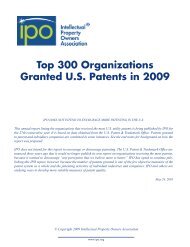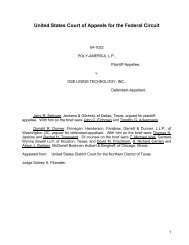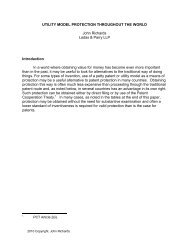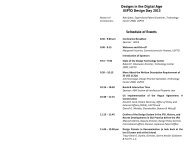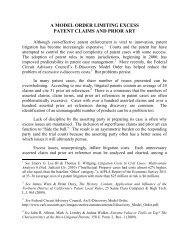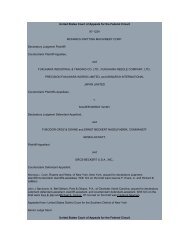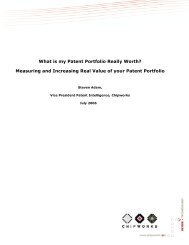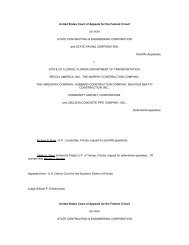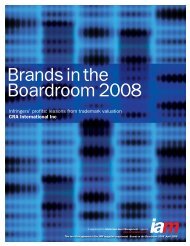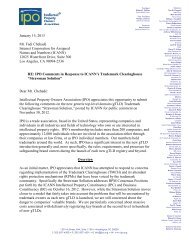IPO Response to the USPTO's Request for Comments - Intellectual ...
IPO Response to the USPTO's Request for Comments - Intellectual ...
IPO Response to the USPTO's Request for Comments - Intellectual ...
You also want an ePaper? Increase the reach of your titles
YUMPU automatically turns print PDFs into web optimized ePapers that Google loves.
April 15, 2013<br />
Hon. Teresa Stanek Rea<br />
Acting Under Secretary of Commerce <strong>for</strong> <strong>Intellectual</strong> Property<br />
and Direc<strong>to</strong>r of <strong>the</strong> U.S. Patent and Trademark Office<br />
600 Dulany Street<br />
P.O. Box 1450<br />
Alexandria, VA 22313<br />
Submitted via: SoftwareRoundtable2013@usp<strong>to</strong>.gov<br />
Re:<br />
Dear Direc<strong>to</strong>r Rea:<br />
President<br />
Richard F. Phillips<br />
Exxon Mobil Corp.<br />
Vice President<br />
Philip S. Johnson<br />
Johnson & Johnson<br />
Treasurer<br />
Carl B. Hor<strong>to</strong>n<br />
General Electric Co.<br />
<strong>IPO</strong> <strong>Response</strong> <strong>to</strong> <strong>the</strong> USPTO’s “<strong>Request</strong> <strong>for</strong> <strong>Comments</strong> … <strong>for</strong><br />
Partnership <strong>for</strong> Enhancement of Quality of Software-Related<br />
Patents 78 Fed. Reg. 292 (January 3, 2013)<br />
<strong>Intellectual</strong> Property Owners Association (<strong>IPO</strong>) submits <strong>the</strong> following comments<br />
pursuant <strong>to</strong> <strong>the</strong> USPTO’s “<strong>Request</strong> <strong>for</strong> <strong>Comments</strong> … <strong>for</strong> Partnership <strong>for</strong> Enhancement of<br />
Quality of Software-Related Patents 78 Fed. Reg. 292 (January 3, 2013) (<strong>the</strong> “Federal<br />
Register notice”).<br />
<strong>IPO</strong> is a trade association representing companies and individuals in all industries and<br />
fields of technology who own or are interested in intellectual property rights. <strong>IPO</strong>’s<br />
membership includes more than 200 companies and more than 12,000 individuals who<br />
are involved in <strong>the</strong> association ei<strong>the</strong>r through <strong>the</strong>ir companies or law firms or as <strong>IPO</strong><br />
individual members.<br />
<strong>IPO</strong> appreciates <strong>the</strong> opportunity <strong>to</strong> participate in <strong>the</strong> USPTO’s recent “listening session”<br />
in New York City. At that event <strong>IPO</strong> stated:<br />
<br />
<br />
<strong>IPO</strong> commends and fully supports <strong>the</strong> USPTO’s continuing ef<strong>for</strong>ts <strong>to</strong><br />
enhance <strong>the</strong> overall quality of all patents including software-related patents<br />
by (1) providing internal training and guidance <strong>for</strong> patent-application<br />
examination, (2) promoting technical training by industry and academic<br />
experts, (3) hiring additional examiners, (4) streng<strong>the</strong>ning guidelines, (5)<br />
implementing post-grant proceedings, (6) encouraging examiner<br />
interviews, and (7) enabling third party submissions of prior art. These<br />
initiatives, as well as <strong>the</strong> present “Software Partnership” activities, are vital<br />
<strong>to</strong> maintaining a strong patent system.<br />
<strong>IPO</strong> believes in <strong>the</strong> fair and equal treatment of all patent applications -- and<br />
<strong>the</strong> underlying technologies and innovations <strong>the</strong>y cover -- <strong>to</strong> yield quality<br />
patents that promote <strong>the</strong> fur<strong>the</strong>r progress of science and <strong>the</strong> useful arts.<br />
Direc<strong>to</strong>rs<br />
Tina M. Chappell<br />
Intel Corp.<br />
Mark Costello<br />
Xerox Corp.<br />
William J. Coughlin<br />
Ford Global Technologies LLC<br />
Robert DeBerardine<br />
Sanofi-Aventis<br />
Gerald L. DePardo<br />
The Travelers Companies, Inc.<br />
Anthony DiBar<strong>to</strong>lomeo<br />
SAP AG<br />
Bart Eppenauer<br />
Microsoft Corp.<br />
Louis Foreman<br />
Enventys<br />
Scott M. Frank<br />
AT&T<br />
Darryl P. Frickey<br />
Dow Chemical Co.<br />
Bernard J. Graves, Jr.<br />
Eastman Chemical Co.<br />
Krish Gupta<br />
EMC Corporation<br />
Henry Hadad<br />
Bris<strong>to</strong>l-Myers Squibb Co.<br />
Jack E. Haken<br />
Koninklijke Philips Electronics N.V.<br />
Alan W. Hammond<br />
Life Technologies Corp.<br />
Dennis R. Hoerner, Jr.<br />
Monsan<strong>to</strong> Co.<br />
Michael Jaro<br />
Medtronic, Inc.<br />
Lisa Jorgenson<br />
STMicroelectronics, Inc.<br />
Charles M. Kinzig<br />
GlaxoSmithKline<br />
David J. Koris<br />
Shell International B.V.<br />
Allen Lo<br />
Google Inc.<br />
Scott McDonald<br />
Mars Incorporated<br />
Steven W. Miller<br />
Procter & Gamble Co.<br />
Douglas K. Norman<br />
Eli Lilly and Co.<br />
Elizabeth A. O’Brien<br />
Covidien<br />
Sean O’Brien<br />
United Technologies, Corp.<br />
Dana Rao<br />
Adobe Systems Inc.<br />
Kevin H. Rhodes<br />
3M Innovative Properties Co.<br />
Mark L. Rodgers<br />
Air Products & Chemicals, Inc.<br />
Curtis Rose<br />
Hewlett-Packard Co.<br />
Mat<strong>the</strong>w Sarboraria<br />
Oracle USA, Inc.<br />
Manny Schecter<br />
IBM, Corp.<br />
Steven Shapiro<br />
Pitney Bowes Inc.<br />
Dennis C. Skarvan<br />
Caterpillar Inc.<br />
Russ Slifer<br />
Micron Technology, Inc.<br />
Terri H. Smith<br />
Mo<strong>to</strong>rola Solutions, Inc.<br />
Daniel J. Staudt<br />
Siemens Corp.<br />
Brian K. Stierwalt<br />
ConocoPhillips<br />
Thierry Sueur<br />
Air Liquide<br />
James J. Trussell<br />
BP America, Inc.<br />
Ka<strong>the</strong>rine Umpleby<br />
Qualcomm, Inc.<br />
Roy Waldron<br />
Pfizer, Inc.<br />
Michael Walker<br />
DuPont<br />
BJ Watrous<br />
Apple Inc.<br />
Stuart Watt<br />
Amgen, Inc.<br />
Paul D. Yasger<br />
Abbott Labora<strong>to</strong>ries<br />
Mike Young<br />
Roche Inc.<br />
General Counsel<br />
Michael D. Nolan<br />
Milbank Tweed<br />
1501 M Street, NW, Suite 1150 ● Washing<strong>to</strong>n, DC 20005<br />
T: 202-507-4500 ● F: 202-507-4501 ● E: info@ipo.org ● W: www.ipo.org<br />
Executive Direc<strong>to</strong>r<br />
Herbert C. Wamsley
INTELLECTUAL PROPERTY OWNERS ASSOCIATION<br />
Singling out a particular class of patent applications, software-related<br />
patent applications in this case, <strong>for</strong> disparate treatment seems unfair and<br />
unjustified.<br />
<br />
<strong>IPO</strong> believes that focus on providing <strong>the</strong> most relevant prior art and<br />
training on prior art searching <strong>to</strong> examiners, implementation of <strong>the</strong><br />
USPTO’s current examining guidelines and training initiatives, and<br />
adherence <strong>to</strong> o<strong>the</strong>r statu<strong>to</strong>ry requirements (e.g., enablement and claim<br />
definiteness) are key <strong>to</strong> enhancing overall patent quality.<br />
Particular focus could move away from over-emphasis on whe<strong>the</strong>r<br />
software-related claims are patent-eligible subject matter and move <strong>to</strong>ward<br />
better evaluating whe<strong>the</strong>r those claims are novel and non-obvious and meet<br />
statu<strong>to</strong>ry requirements including enablement and definiteness.<br />
<br />
<strong>IPO</strong> supports <strong>the</strong> USPTO’s commitment <strong>to</strong> enhancing <strong>the</strong> quality of<br />
software-related patents and establishing this partnership and open dialogue<br />
with <strong>the</strong> software community with a view <strong>to</strong>ward identifying specific issues<br />
and seeking constructive input from all participants.<br />
With <strong>the</strong>se principles in mind, <strong>IPO</strong> presents <strong>the</strong> following comments on <strong>the</strong> <strong>to</strong>pics presented in<br />
<strong>the</strong> Federal Register notice.<br />
Topic 1: Establishing Clear Boundaries <strong>for</strong> Claims That Use Functional Language<br />
1. When means-plus-function style claiming under 35 U.S.C. 112(f) is used in<br />
software-related claims, indefinite claims can be divided in<strong>to</strong> two distinct<br />
groups: claims where <strong>the</strong> specification discloses no corresponding structure;<br />
and claims where <strong>the</strong> specification discloses structure but that structure is<br />
inadequate. In order <strong>to</strong> specify adequate structure and comply with 35 U.S.C.<br />
112(b), an algorithm must be expressed in sufficient detail <strong>to</strong> provide means<br />
<strong>to</strong> accomplish <strong>the</strong> claimed function. In general, are <strong>the</strong> requirements of 35<br />
U.S.C. 112(b) <strong>for</strong> providing corresponding structure <strong>to</strong> per<strong>for</strong>m <strong>the</strong> claimed<br />
function typically being complied with by applicants and are such<br />
requirements being applied properly during examination? In particular:<br />
a) Do supporting disclosures adequately define any structure<br />
corresponding <strong>to</strong> <strong>the</strong> claimed function?<br />
b) If some structure is provided, what should constitute sufficient<br />
“structural” support?<br />
c) What level of detail of algorithm should be required <strong>to</strong> meet <strong>the</strong> sufficient<br />
structure requirement?<br />
- 2 -
INTELLECTUAL PROPERTY OWNERS ASSOCIATION<br />
RESPONSE: Patent quality improves when (1) <strong>the</strong> scope of an issued claim is clear, and (2) <strong>the</strong><br />
claim has been examined thoroughly, taking in<strong>to</strong> account all statu<strong>to</strong>ry requirements <strong>for</strong><br />
patentability. <strong>IPO</strong> commends <strong>the</strong> USPTO’s ef<strong>for</strong>ts <strong>to</strong> investigate ways <strong>to</strong> clarify claim<br />
boundaries. The goal of “clear” boundaries, however, should not be confused with “narrow”<br />
boundaries. Any new rules designed <strong>to</strong> clarify claim scope should be crafted carefully <strong>to</strong> avoid<br />
unfairly burdening applicants by ei<strong>the</strong>r unduly raising <strong>the</strong> cost of preparing and prosecuting <strong>the</strong><br />
application, or unduly narrowing <strong>the</strong> scope of protection.<br />
Generally speaking, some applications include disclosures that adequately define structure<br />
corresponding <strong>to</strong> functional language claimed using 35 U.S.C. § 112(f), and some do not.<br />
Disclosure of at least a software algorithm in <strong>the</strong> <strong>for</strong>m of a flowchart or pseudo-code <strong>for</strong> <strong>the</strong><br />
claimed function that shows how <strong>the</strong> claimed function is per<strong>for</strong>med by a structure should be<br />
sufficient support in most cases <strong>for</strong> a claimed function that invokes § 112(f).<br />
In a means-plus-function claim in which <strong>the</strong> disclosed structure is a computer, or microprocessor,<br />
programmed <strong>to</strong> carry out an algorithm, it is now well established that <strong>the</strong> disclosed structure is<br />
not <strong>the</strong> general purpose computer but ra<strong>the</strong>r <strong>the</strong> special purpose computer programmed <strong>to</strong><br />
per<strong>for</strong>m <strong>the</strong> disclosed algorithm. See Aris<strong>to</strong>crat Techs. Australia Pty Ltd. v. Int’l Game Tech.,<br />
521 F.3d 1328, 1333 (Fed. Cir. 2008); Finisar Corp. v. DirecTV Group, Inc., 523 F.3d 1323,<br />
1340 (Fed. Cir. 2008); and WMS Gaming, Inc. v. Int’l Game Tech., 184 F.3d 1339, 1349 (Fed.<br />
Cir. 1999). An algorithm is defined, <strong>for</strong> example, as “a finite sequence of steps <strong>for</strong> solving a<br />
logical or ma<strong>the</strong>matical problem or per<strong>for</strong>ming a task.” Microsoft Computer Dictionary,<br />
Microsoft Press, 5th edition, 2002. An applicant may express <strong>the</strong> algorithm in any<br />
understandable terms including as a ma<strong>the</strong>matical <strong>for</strong>mula, in prose, in a flow chart, or ‘‘in any<br />
o<strong>the</strong>r manner that provides sufficient structure.’’ Finisar, 523 F.3d at 1340; see also Intel Corp. v.<br />
VIA Techs., Inc., 319 F.3d 1357, 1366 (Fed. Cir. 2003); and In re Dossel, 115 F.3d 942, 946–47<br />
(1997).<br />
The level of detail of algorithm that should be required <strong>to</strong> meet <strong>the</strong> sufficient structure<br />
requirement will vary from case <strong>to</strong> case. For example, where implementation of a particular step<br />
in <strong>the</strong> process is not within <strong>the</strong> skill of <strong>the</strong> person of ordinary skill in <strong>the</strong> art, additional disclosure<br />
regarding <strong>the</strong> particular step may be required. A clear understanding of <strong>the</strong> scope of <strong>the</strong> claim in<br />
such cases might require disclosure of a specific software module (i.e., actual lines of code or<br />
pseudo-code). Still, sufficient structural support <strong>for</strong> per<strong>for</strong>ming <strong>the</strong> claimed function should not<br />
have <strong>to</strong> include any physical structure like hardware (i.e., processor, memory, etc.). Software<br />
has a structure all its own, and may be claimed. Object-oriented code, <strong>for</strong> example, has structure<br />
in <strong>the</strong> way that <strong>the</strong> classes are defined and data encapsulated. As ano<strong>the</strong>r example, databases<br />
have structure in <strong>the</strong> database schemas, and <strong>the</strong> way that tables are linked.<br />
The test <strong>for</strong> whe<strong>the</strong>r disclosed structure is sufficient <strong>for</strong> § 112(f) should be <strong>the</strong> same <strong>for</strong> all patent<br />
applications, i.e., whe<strong>the</strong>r <strong>the</strong> written description and drawings associate structure with <strong>the</strong><br />
claimed function, and whe<strong>the</strong>r that structure is sufficient <strong>to</strong> per<strong>for</strong>m <strong>the</strong> claimed function. The<br />
disclosed structure must be linked <strong>to</strong> <strong>the</strong> function recited in <strong>the</strong> claim and be detailed enough <strong>to</strong><br />
<strong>for</strong>m a reasonable range of equivalents. This requirement <strong>for</strong> § 112(f) claims is distinct from <strong>the</strong><br />
enablement requirement. Once § 112(f) applies, “[t]he trade-off <strong>for</strong> allowing [functional §<br />
112(f)] claiming is that <strong>the</strong> specification must contain sufficient descriptive text by which a<br />
- 3 -
INTELLECTUAL PROPERTY OWNERS ASSOCIATION<br />
person of skill in <strong>the</strong> field of <strong>the</strong> invention would know and understand what structure<br />
corresponds <strong>to</strong> <strong>the</strong> means limitation.” Function Media, at *4 (internal citations and punctuation<br />
omitted). And, “[t]he specification can express <strong>the</strong> algorithm in any understandable terms<br />
including as a ma<strong>the</strong>matical <strong>for</strong>mula, in prose, or as a flow chart, or in any o<strong>the</strong>r manner that<br />
provides sufficient structure.” Id.<br />
The question is whe<strong>the</strong>r a person of skill in <strong>the</strong> art would recognize how <strong>the</strong> algorithm disclosed<br />
in <strong>the</strong> patent per<strong>for</strong>ms <strong>the</strong> “function” of <strong>the</strong> functional claim. “[T]he proper inquiry <strong>for</strong> purposes<br />
of section 112[(f)] analysis is <strong>to</strong> look at <strong>the</strong> disclosure of <strong>the</strong> patent and determine if one of skill<br />
in <strong>the</strong> art would have unders<strong>to</strong>od that disclosure <strong>to</strong> encompass software <strong>to</strong> per<strong>for</strong>m <strong>the</strong> function<br />
and been able <strong>to</strong> implement such a program, not simply whe<strong>the</strong>r one of skill in <strong>the</strong> art would<br />
have been able <strong>to</strong> write such a software program.” Aris<strong>to</strong>crat Tech. at 1337 (emphasis in original,<br />
internal citations and punctuation omitted). Stated ano<strong>the</strong>r way, <strong>the</strong> issue under § 112(f) is not<br />
whe<strong>the</strong>r a person of skill in <strong>the</strong> art can implement some version of <strong>the</strong> claimed function<br />
(enablement), but instead whe<strong>the</strong>r one of skill in <strong>the</strong> art would understand <strong>the</strong> specification <strong>to</strong><br />
describe an implementation of <strong>the</strong> claims. If such an implementation is present, <strong>the</strong> functional §<br />
112(f) claim elements are limited <strong>to</strong> <strong>the</strong> scope of <strong>the</strong> implementation and its equivalents.<br />
2. In software-related claims that do not invoke 35 U.S.C. 112(f) but do recite<br />
functional language, what would constitute sufficient definiteness under 35<br />
U.S.C. 112(b) in order <strong>for</strong> <strong>the</strong> claim boundaries <strong>to</strong> be clear? In particular:<br />
a) Is it necessary <strong>for</strong> <strong>the</strong> claim element <strong>to</strong> also recite structure sufficiently<br />
specific <strong>for</strong> per<strong>for</strong>ming <strong>the</strong> function?<br />
b) If not, what structural disclosure is necessary in <strong>the</strong> specification <strong>to</strong><br />
clearly link that structure <strong>to</strong> <strong>the</strong> recited function and <strong>to</strong> ensure that <strong>the</strong><br />
bounds of <strong>the</strong> invention are sufficiently demarcated?<br />
RESPONSE: If § 112(f) is not invoked, <strong>the</strong>re should be no special rule <strong>for</strong> software-related<br />
inventions. The general test <strong>for</strong> claim definiteness under § 112(b) as interpreted by <strong>the</strong> Federal<br />
Circuit should be applied by <strong>the</strong> USPTO.<br />
3. Should claims that recite a computer <strong>for</strong> per<strong>for</strong>ming certain functions or<br />
configured <strong>to</strong> per<strong>for</strong>m certain functions be treated as invoking 35 U.S.C.<br />
112(f) although <strong>the</strong> elements are not set <strong>for</strong>th in conventional means-plusfunction<br />
<strong>for</strong>mat?<br />
RESPONSE: Claims should not be analyzed according <strong>to</strong> bright line rules like that recited<br />
here. Ra<strong>the</strong>r claims should be analyzed on a case by case basis <strong>for</strong> whe<strong>the</strong>r <strong>the</strong>y contain<br />
functional language and supporting structure. The test <strong>for</strong> whe<strong>the</strong>r §112(f) is invoked should be<br />
<strong>the</strong> same <strong>for</strong> all patent applications.<br />
- 4 -
INTELLECTUAL PROPERTY OWNERS ASSOCIATION<br />
Topic 2: Future Discussion Topics <strong>for</strong> <strong>the</strong> Software Partnership<br />
The USPTO is seeking public input on <strong>to</strong>pics related <strong>to</strong> enhancing <strong>the</strong><br />
quality of software-related patents <strong>to</strong> be discussed at future Software<br />
Partnership events. The <strong>to</strong>pics will be used in an ef<strong>for</strong>t <strong>to</strong> extend and<br />
expand <strong>the</strong> dialogue between <strong>the</strong> public and <strong>the</strong> USPTO regarding<br />
enhancing quality of software-related patents. … Input ga<strong>the</strong>red from <strong>the</strong>se<br />
events, may be used as <strong>the</strong> basis <strong>for</strong> internal training ef<strong>for</strong>ts and quality<br />
initiatives. One potential <strong>to</strong>pic <strong>for</strong> future discussion is how determinations<br />
of obviousness or nonobviousness of software inventions can be improved.<br />
Ano<strong>the</strong>r potential <strong>to</strong>pic is how <strong>to</strong> provide <strong>the</strong> best prior art resources <strong>for</strong><br />
examiners beyond <strong>the</strong> body of U.S. Patents and U.S. Patent Publications.<br />
Additional <strong>to</strong>pics are welcomed.<br />
RESPONSE: <strong>IPO</strong> supports <strong>the</strong> USPTO’s interest in discussing additional <strong>to</strong>pics concerning<br />
patent quality. In particular, <strong>IPO</strong> agrees that <strong>to</strong>pics <strong>for</strong> future discussion could include (1) how<br />
determinations of obviousness or nonobviousness of software inventions can be improved, and<br />
(2) how <strong>to</strong> provide <strong>the</strong> best prior art resources <strong>for</strong> examiners beyond <strong>the</strong> body of U.S. Patents and<br />
U.S. Patent Publications.<br />
An additional <strong>to</strong>pic may include: How do we move <strong>the</strong> conversation from “is software<br />
patentable?” <strong>to</strong> “how can we improve <strong>the</strong> patent system <strong>to</strong> deal with issues that software-related<br />
patents and patent applications may present <strong>to</strong> <strong>the</strong> system?”<br />
* * * * *<br />
<strong>IPO</strong> thanks <strong>the</strong> USPTO <strong>for</strong> considering <strong>the</strong>se comments and would welcome any fur<strong>the</strong>r dialogue or<br />
opportunity <strong>to</strong> provide additional in<strong>for</strong>mation <strong>to</strong> assist in <strong>the</strong> Office’s ef<strong>for</strong>ts on this issue.<br />
Sincerely,<br />
Richard F. Phillips<br />
President<br />
- 5 -


